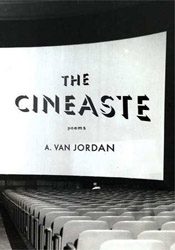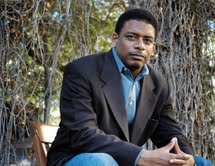
What would it be like to go to the movies with someone who has superior taste in movies? A. Van Jordan’s tastes in movies are probably better than yours. His fourth, The Cineaste, expresses his tastes in movies, and it is his best book (so far).
The book uses form and an interdisciplinary approach to film in a refreshing and intellectually rigorous way. The book also shows how the poet’s private memories of his favorite films intertwine and coexist with the reader’s memories of those films in ways that intensify both sets of memories. For example, in “Nosferatu,” a poem about the 1922 F.W. Murnau film about Dracula, fragments of the film allow for the speaker—a stunt-double for Jordan himself—to enter the screen:
Some pieces
are not meant for the puzzle of my heart
to solve. Call me what you may—
Nosferatu, Dracule, A. Van—but
the other Van, the good Dr. Helsing,
pointed out in The Book of Vampires
what I couldn’t comprehend: The cure
for my bite lies in the blood of “a woman,
pure of heart.”
The book is not autobiographical, but allows the speakers of the poems to engage the fiction of film. It does not use film so much as its subject matter—it is not “about” these movies—instead it cross-examines the experience of watching films about which the reader is perhaps ambivalent. In this cross-examination, Jordan’s true subject is the historical understanding that comes from film, the uses of film in bearing witness, and the possibilities for innovation in using poetry to write about cinema.
For example, “Last Year at Marienbad” uses abstraction, rhetorical questions, and tercet form to interrogate the ephemeral way desire and fantasy can take material form. In the way the film plays with doubt, shadow, and mystery, the poem’s slow and methodical motions mirror the film’s subjects in a new way. Jordan uses the styles and subjects of the films not to summarize or paraphrase, but as a springboard for the way their themes have affected the speakers’ own lives. In this book, film is both subject and form; in this way it is not unlike the way Charles Simic’s Dime Store Alchemy uses Joseph Cornell’s shadow boxes or Thomas Bernhard’s Old Masters: A Comedy uses Tintoretto.
To this end, Jordan’s poetic form becomes the unifying structure between the awkward back-and-forth between poems and movies. “Pather Panchali,” a 1955 Santyajit Ray film, is a ghazal. “Run Lola Run” comments on the film’s frantic and expressive circular form as terzina rima. Jordan also uses sonnets several times, but refreshes them by using only seven end-words that repeat rather than rhyme.
 The centerpiece of the book is a long, demanding, middle section, “The Homesteader,” which takes the arrest, trial, and extra-legal lynching of Leo Frank in 1915 as its context. The series of more than 40 poems uses this event, and the pioneering black turn-of-century filmmaker, Oscar Micheaux, to explore race in the years 1902-1919. Frank was a Jewish-American factory superintendent who was convicted of killing a 13 year-old factory worker, Mary Phagan. Frank was killed by lynch mob of prominent citizens in Marietta, Georgia in 1915. Since Frank’s murder reflected racist fantasies of the time, Jordan employs a lost 1919 Micheaux film, The Homesteader, to understanding the poetic dimensions of historical literature and the historical dimension of poetry.
The centerpiece of the book is a long, demanding, middle section, “The Homesteader,” which takes the arrest, trial, and extra-legal lynching of Leo Frank in 1915 as its context. The series of more than 40 poems uses this event, and the pioneering black turn-of-century filmmaker, Oscar Micheaux, to explore race in the years 1902-1919. Frank was a Jewish-American factory superintendent who was convicted of killing a 13 year-old factory worker, Mary Phagan. Frank was killed by lynch mob of prominent citizens in Marietta, Georgia in 1915. Since Frank’s murder reflected racist fantasies of the time, Jordan employs a lost 1919 Micheaux film, The Homesteader, to understanding the poetic dimensions of historical literature and the historical dimension of poetry.
The book’s arc begins with the local and personal, a memory of a child going to the movies with his family in Akron: “I believed I would do something with my potential / once I simply grew up. Like many adults, I / stayed a child; potential hanging around like a shadow.” The book ends with “Oldboy,” about the 2003 Park Chan-Wook film about disturbing sadism and vengeance. The poem ends with an idea that “the tongue continues to confess”—an allusion to the film’s shocking ending—but also suggests that the poems take from the screen a kind of psychoanalytical confessional. But what do the poems confess?
One aspect of the book is less successful than the rest, and this misstep is an editorial one. The notes in the back of the book, containing summaries of the films’ plots along with brief anecdotes about how, when, or where Jordan first saw the films undermines the sense of completed statement. They’re notes for observations and paraphrase that couldn’t fit into the poems themselves, suggesting that the reader needs a crutch to get through the allusions to the films. It’s as if the idea is that the reader needs a narrative or commentary to watch the films with Jordan. The poems are exhilarating and complex, and the notes take all the air out—like a cake fell in the oven. Do poems stand on their own, or do they need notes to explain them? So, invoke your inner Robin Williams in Dead Poets Society, a film fortunately not discussed here, and tear out the notes.
The Cineaste is one of those books that you had wished you had written. Sophisticated, subtle, technically supreme, and passionate, the book uses poems in a fresh way to talk about film with surprising insights.




